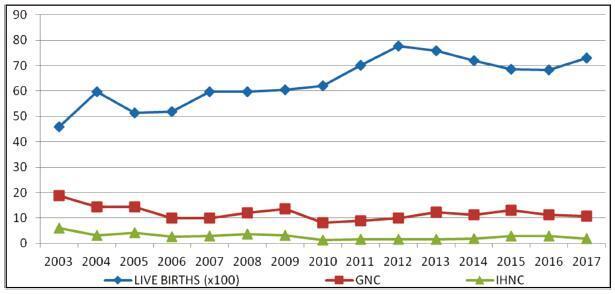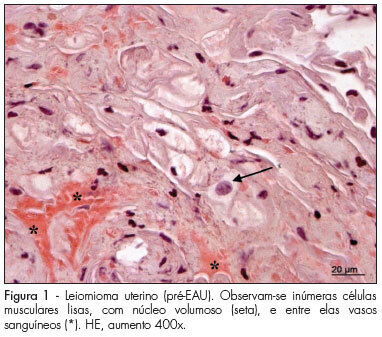Summary
Revista Brasileira de Ginecologia e Obstetrícia. 2019;41(10):597-606
To evaluate conditions associated with stillbirth (SB), and possible trends related with it, in a maternity hospital school in the North zone of São Paulo.
An observational, cross-sectional study conducted at the Hospital Maternidade- escola de Vila Nova Cachoeirinha with 1,139 SBs in the period of 2003 to 2017. Cases of intermediate SB (ISB) (weight between 500 and 999 g) and late SB (LSB) (weight ≥ 1,000 g) were compared. We evaluated clinical data, laboratory tests, and fetal and placental studies. Data were stored in Windows Excel (Microsoft Corp., Redmond, WA, USA) worksheets, according to which graphs and tables were constructed. We used the statistical software SPSS for Windows version 18.0 (SPSS In., Chicago, IL, USA), estimating the prevalence ratio (PR) and odds ratio (OR), considering the 95% confidence interval (95% CI).
The general SB rate was 11.9%, and the in-hospital SB rate was 2.8%. Pregnant women younger than 16 years of age were more likely to have ISB (OR 0.32, 0.15- 0.76), while patients older than 40 years old had a higher chance of LSB (PR 0.85, 0.72- 0.99). A total of 25.7% of the general population did not have prenatal care, and 77.1% of the cases presented fetal death at admission. The cases of ISB had a statistically significant association with home birth (OR 0.61, 0.46-0.80). Cesarean section was performed in 16.1% of the subjects, and misoprostol was the most used method for induction. Necropsy and placental study of the fetuses were performed, respectively, in 94.2% and 97.3% of the cases. Associated causes were not identified in 22.1% of the cases, and the main causes identified were amniotic sac infections (27.9%), fetal malformations (12.5%), placental abruption (11.2%), hypertensive syndromes (8.5%), and maternal syphilis (3.9%), the latter with an increasing trend.
Among the factors associated to SB were: hypertensive syndromes, amniotic sac infections, fetal malformations, placental abruption and syphilis. There was a growing trend in the number of cases of syphilis, which translates an alert. Diagnostic limitations justify indeterminate causes.

Summary
Revista Brasileira de Ginecologia e Obstetrícia. 2000;22(9):597-597
DOI 10.1590/S0100-72032000000900011
Summary
Revista Brasileira de Ginecologia e Obstetrícia. 2000;22(9):597-597
DOI 10.1590/S0100-72032000000900010
Summary
Revista Brasileira de Ginecologia e Obstetrícia. 2009;31(12):598-603
DOI 10.1590/S0100-72032009001200004
PURPOSE: to analyze histomorphometric consequences of the uterine arteries embolization (UAE) in the uterine tissue, especially by collagen tissue quantification through uterine biopsy, before and after treatment of uterine leiomyoma. METHODS: 15 patients with symptomatic leyomioma and/or infertility, submitted to UAE, participated in the study according to the study exclusion criteria, after having signed an informed consent. Uterine biopsy was performed in the secretory phase of the menstrual cycle, before and three months after the procedure, to evaluate the collagen. After the histological processing of the material, 3 µ slices were prepared, some of them dyed with hematoxiline-eosin (HE) and others with the specific dye for collagen fibers (Picrosirius red). Then, the slides were examined and interpreted, and the collagen quantified. The amount was calculated as the percent of the area composed by collagen, and the result expressed in mean±standard deviation (SD). Data has then been submitted to statistical analysis by Student's paired t test (p<0.05). RESULTS: the presence of smooth muscle cells was observed in the biopsies performed before the treatment, surrounded by a rich network of collagen fibers, which are part of the tumor, blood vessels and fibroblast nuclei. On the slides of biopsies performed after the treatment, it was observed the presence of widespread coagulation necrosis, vascular thrombosis, calcification and lymphoplasmocitary infiltration areas and clear reduction of the collagen component. The percentage of collagen fibers was higher in the pre-UAE group (84.07±1.41), than in the post-UAE (81.05±1.50) group, with p<0.0001, and 95% confidence interval (CI95%) from 2.080 to 3.827. CONCLUSION: the quantitative and qualitative collagen reduction clearly shows that the proposed treatment is efficient in reducing the tumoral mass, composed mainly by collagen fibers intermingled with neoplasic smooth muscle cells. Nevertheless, complementary studies are needed to investigate the functional and biological consequences of these histological changes.

Summary
Revista Brasileira de Ginecologia e Obstetrícia. 2005;27(10):599-606
DOI 10.1590/S0100-72032005001000006
PURPOSE: comparative analysis of the outcome of women with advanced pelvic endometriosis and women with tubal sterilization submitted to intracytoplasmic sperm injection (ICSI). METHODS: ninety-three infertile women, with normal menstrual cycle, without hormonal or surgical treatment during 12 months, body mass index of 20-25, ovaries with no tumors or cysts were included in the present study and divided into two groups: tubal sterilization (TUB), 39 women, and endometriosis (EDT), 54 women with III-EDT and IV-EDT, undergoing ovulatory induction using r-FSH and ICSI. Clinical and laboratorial data were compared. chi2, Fisher, Student's t, and Mann-Whitney tests were employed. RESULTS: lower estradiol levels (2,243.1 vs 1,666.3; p=0.001) and lower number of follicles per patient (16.9 vs 13.9, p=0.001) were noted in EDT group, in spite of more units of r-FSH (1,775.6 vs 1,998.6; p=0.007, for TUB and EDT, respectively). There were no differences in the rates of retrieved oocyte (69 vs 73.5%; p=0.071) as well as in normal fertilization rates (83.7 vs 81.7%; p=0.563, for TUB and EDT, respectively. However, lower number of top quality preembryos were obtained in patients from EDT group (36.5 vs 24.8%, TUB and EDT, respectively; p=0.005). Total pregnancy (41.0 vs 42.6%; p=0.950) and implantation rates (13.9 vs 14.5%; p=0.905) were not different when groups TUB and EDT were compared. CONCLUSIONS: ovaries of women from EDT group seem to be less responsive to ovulatory induction with r-FSH. EDT seems to impair the mean number of follicles and top quality preembryos with no impairment of retrieved oocyte and fertilization rates. However, once obtained, preembryos from EDT patients are able to exhibit similar implantation potential and pregnancy when compared with patients from TUB group.
Summary
Revista Brasileira de Ginecologia e Obstetrícia. 2018;40(10):599-605
We have evaluated the prevalence of and the motivating factors behind the refusal to provide reproductive health services and the ethical knowledge of the subject among medical students from the Escola Bahiana de Medicina e Saúde Pública, in the state of Bahia, Brazil.
The present cross-sectional study involved 120 medical students. A questionnaire was utilized. The dependent variables were students’ objections (or not) regarding three clinical reproductive health cases: abortion provided by law, contraceptive guidance to an adolescent without parental consent, and prescription of emergency contraception. The independent variables were age, gender, religion, ethical value, degree of religiosity, and attendance at worship services. Ethical knowledge comprised an obligation to state the reasons for the objection, report possible alternatives, and referral to another professional. Data were analyzed with χ2 tests and t-tests with a significance level of 5%.
Abortion, contraception to adolescents, and emergency contraception were refused by 35.8%, 17.5%, and 5.8% of the students, respectively. High religiosity (p < 0.001) and higher attendance at worship services (p = 0.034) were predictors of refusing abortion. Refusal to provide contraception to adolescents was significantly higher among women than men (p = 0.037). Furthermore, 25% would not explain the reason for the refusal, 15% would not describe all the procedures used, and 25% would not refer the patient to another professional.
Abortion provided by law was the most objectionable situation. The motivating factors for this refusal were high commitment and religiosity. A reasonable portion of the students did not demonstrate ethical knowledge about the subject.
Summary
Revista Brasileira de Ginecologia e Obstetrícia. 2003;25(8):599-603
DOI 10.1590/S0100-72032003000800009
PURPOSE: the aim was to study Rh-alloimmunized pregnant women and describe the gasometric abnormalities and the fetal acid-base changes before and after intrauterine transfusion. METHODS: between June 2001 and October 2001, before and after intrauterine transfusion in the alloimunized fetuses, gasometric data and acid-base parameters were prospectively studied in the umbilical vein blood. The measurements were performed in 8 samples of 5 fetuses. The fetal blood was obtained by cordocentesis before and after the intrauterine transfusion. The results were compared to the volemic expansion, the gestational age at procedure, the estimated fetal weight and the hemoglobin values (g/dL). RESULTS: all the cases showed pH value reduction, mean of 0.09 (SD=0.02). The fetal hemoglobin value showed a mean improvement of 8.4 g/dL (SD=2.9 g/dL). The pO2 and HCO3- concentrations showed negative variation (mean deltapO2 = -1.28 mmHg, mean deltaHCO3- = -2.25 mEq/L). pCO2 showed improvement (mean deltapCO2 = 3.2 mmHg) and reduced values of base excess occurred (mean = -3.75). CONCLUSION: the gasometric analysis allows to conclude that intrauterine transfusion is followed by pH reduction in the umbilical vein, with relative fetal acidemia after the procedure.
Summary